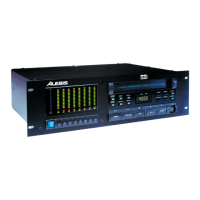CHAPTER 1: INTRODUCTION
1.0 ABOUT ADAT
Congratulations. You've just purchased an incredible piece of recording equipment.
Here are a few of the features that make the ADAT Digital Recorder perhaps one of
the most important advances in recording technology since the invention of multi-
track. These features are of equal significance to the professional commercial studio
and the personal home or project studio:
• Low tape cost. ADAT records approximately 40 minutes of audio on a standard
S-VHS
®
tape cassette. This is the same tape that is used with S-VHS video tape
recorders. It's readily available and relatively low in cost for the purpose of multi-
track recording. We chose S-VHS because the cassette shell, tape hubs and
guides are precision crafted in the S-VHS format to treat the tape gently and
interface in a precisely controlled manner with the ADAT transport over long
periods of recording. We recommend you always use S-VHS tape to protect your
valuable recordings. Your ADAT was packed with a complimentary Alesis S-VHS
Mastering Audio Cassette. It should perform to your highest expectations. You
can order more through your Alesis dealer or directly from Alesis. See the
accompanying flyer for information on how to order.
• Superb fidelity. ADAT uses 16-bit linear analog-to-digital conversion, the
professional standard 48 kHz sampling rate (variable from 40.4kHz to 50.85kHz),
and 64 times oversampling for better-than-CD quality sound.
• Ultra high fidelity digital converters. The digital converters in ADAT are the
latest generation in converter technology.
®
VHS is a registered trademark of JVC.
Because of the tremendous economies of scale realized in manufacturing ADAT,
these high quality and
more expensive converters are included in the ADAT design (rather than having to
be purchased as a separate accessory box as with some recorders) in spite of
ADATs low overall cost. This converter technology allows recording and
reproduction of the very highest quality. Plus, ADAT's design dedicates separate
converters to the inputs and outputs of each individual track. That's 16 converters
in all - no multiplexing.
• Easy and familiar front panel controls. If you've ever used a multitrack tape
recorder, then you probably already know how to use ADAT. Familiar controls
like play, record, fast forward, rewind, and track select buttons perform the major-
ity of functions you'll need. There are no difficult engineering routines for you to
learn.

